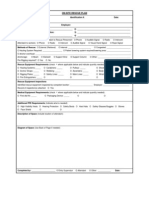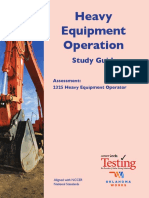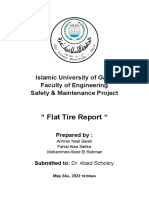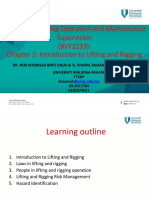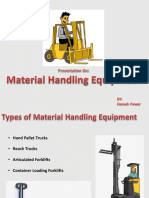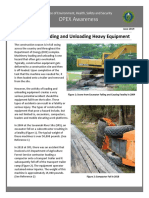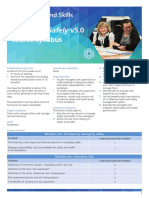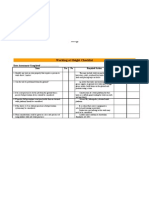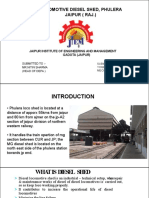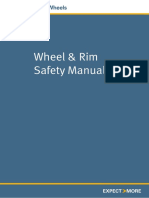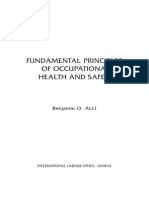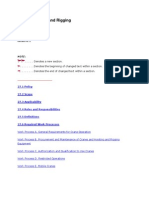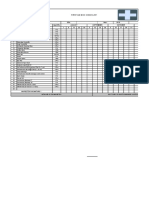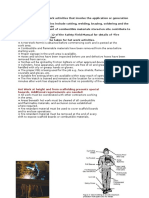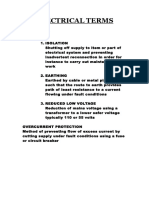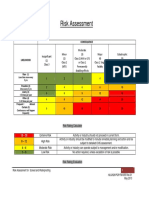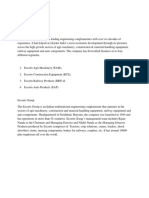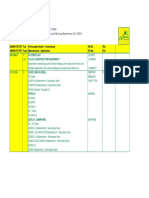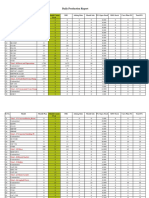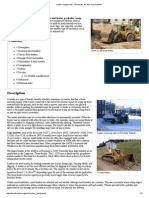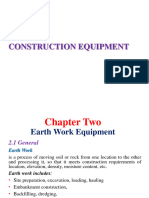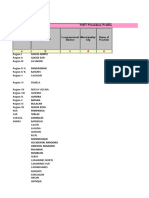Heavy Equipment
Heavy Equipment
Uploaded by
テレブリコ ジェファーソンCopyright:
Available Formats
Heavy Equipment
Heavy Equipment
Uploaded by
テレブリコ ジェファーソンCopyright
Available Formats
Share this document
Did you find this document useful?
Is this content inappropriate?
Copyright:
Available Formats
Heavy Equipment
Heavy Equipment
Uploaded by
テレブリコ ジェファーソンCopyright:
Available Formats
Toolbox Talk:
Working around Heavy Equipment
Background
75% of construction related struck by and run over fatalities involve heavy equipment. The use of such
equipment is essential on the majority of O&G projects.
The following apparatus are commonly used on O&G job sites:
Tri-axle dump trucks
Cranes
Pay loaders
Bull dozers
Excavators
Skid steers
Graders
Aerial lifts
Scissor lifts
Forklifts
Pavers
Milling machines
Who This Topic Applies To
Working in the presence of Heavy Equipment applies to all O&G employees, contractors and visitors. This can
even apply to pedestrians traveling on the road. The hazards do not go away when the equipment leaves the
project or facility.
Safety Tips
Safely working in the area of any heavy equipment requires the shared responsibility of both the equipment
operator and their coworkers. As with all O&G ventures, each project must have a prepared and wellarticulated safety plan. This preparation is both a written document and a shared dialogue with all O&G
employees and subcontractors at the beginning of each project as well as each shift.
Consideration should be given to issues related to working around heavy equipment:
Inspection of the equipment prior to operation to ensure that all lights and audible alarms are working
properly.
A Publication of O&G Corporate Safety ogind.com/safety
Toolbox Talk Topic, Rev. 05/01/2015
A defined route and clear visual path for the operator when moving equipment from the point of origin
to the work site.
Set up of the equipment at the work area should be stable and have enough space to allow the
equipment and workers to perform the planed tasks.
Use 3 point mounting and dismounting technique off of heavy equipment - NEVER JUMP OFF HEAVY
EQUIPMENT.
Establish a danger zone, that is; the working area where contact could result in personal injury or
damage during operations.
Predefined hand signals or use of two way radios between the operator and person in charge of the
work crew to accomplish any and all movement.
Maintain a clear line of site between the operator and workers. Blind spots are common. If you cant
see the operator, they cant see you.
Use a spotter when heavy equipment is in motion. This requires communication between the operator
and workers to maintain safe movement.
Always try to walk on the driver side of equipment as the passenger side has a larger blind spot.
Workers should keep a safe distance from all sides of the heavy equipment while it is in use.
Be aware of the swing radius on certain equipment and, if possible, cordon off the area with barriers or
caution tape.
Wear high visibility clothing and Personal Protective Equipment
Never work under a suspended or overhead load
Always stay alert
Many times when workers think they can be seen by the operators of heavy equipment they cant. You may be
in a blind spot or the operator has been driving is a designated travel path for a period of time and the only thing
that has changed is you!!!!! Make eye contact with operators
Other Topics Discussed:
________________________________________________________
________________________________________________________
What To Do If You Spot Safety Issues
Notify the operator immediately. Advise your coworkers and supervisor and help take corrective action.
If you have not been properly trained on this topic, do not have the proper safety
equipment available for use or you are not comfortable with what you are being asked to
do, DO NOT PROCEED until the expected safety standards have been met.
If you have questions or concerns, please contact O&Gs Safety Department. You may
also contact the O&G Safety Hotline anonymously by calling (860) 496-4866.
A Publication of O&G Corporate Safety ogind.com/safety
Toolbox Talk Topic, Rev. 05/01/2015
Toolbox Talk Topic Name
PROJECT INFORMATION
Project Name:
Contractor Name:
Toolbox Talk Date:
By signing this document, I acknowledge that I participated in the above referenced Toolbox Talk and that I fully
understand the elements of this training.
Print Name
Signature
______________________________________
____________________________________________
______________________________________
____________________________________________
______________________________________
____________________________________________
______________________________________
____________________________________________
______________________________________
____________________________________________
______________________________________
____________________________________________
______________________________________
____________________________________________
______________________________________
____________________________________________
______________________________________
____________________________________________
______________________________________
____________________________________________
______________________________________
____________________________________________
______________________________________
____________________________________________
______________________________________
____________________________________________
______________________________________
____________________________________________
______________________________________
____________________________________________
______________________________________
____________________________________________
If you have additional questions, please contact your Supervisor or the Safety Department.
A Publication of O&G Corporate Safety ogind.com/safety
Toolbox Talk Topic, Rev. 05/01/2015
You might also like
- Confined Space Rescue PlanDocument2 pagesConfined Space Rescue PlanSara Scherer88% (8)
- Hyundai R210lc 7a Crawler Excavator Workshop Service Repair ManualDocument5 pagesHyundai R210lc 7a Crawler Excavator Workshop Service Repair Manualanzor67% (9)
- Heavy Equipment Operation Study GuideDocument24 pagesHeavy Equipment Operation Study GuideLj DomingoNo ratings yet
- Fleet Safety Program TemplateDocument33 pagesFleet Safety Program TemplateStelaNo ratings yet
- SlamDocument8 pagesSlamClinton Eric HuntNo ratings yet
- Safe Operation and Use of Mobile Jaw CrushersDocument7 pagesSafe Operation and Use of Mobile Jaw Crushersテレブリコ ジェファーソンNo ratings yet
- (HSE-001) - HSE Engineering PDFDocument2 pages(HSE-001) - HSE Engineering PDFテレブリコ ジェファーソン100% (2)
- Cat Equipment CatalogueDocument32 pagesCat Equipment CatalogueGeorge JabbourNo ratings yet
- Flat Tire ReportDocument8 pagesFlat Tire ReportAhmad AliNo ratings yet
- ROLLERDocument40 pagesROLLEROmosigho OsaroNo ratings yet
- Safety Circles : Among The EmployeesDocument3 pagesSafety Circles : Among The Employeespartha moulikNo ratings yet
- Cargo Securement QuizDocument3 pagesCargo Securement Quizahmed naveedNo ratings yet
- Respiratory Protection TrainingDocument29 pagesRespiratory Protection Trainingzhou wangchaoNo ratings yet
- Technical Test Theory: Compact Crane A66Document6 pagesTechnical Test Theory: Compact Crane A66memoNo ratings yet
- BVF2233 - Chapter 1 (Introduction To Lifting and Rigging) 01Document65 pagesBVF2233 - Chapter 1 (Introduction To Lifting and Rigging) 01Muhamad arifNo ratings yet
- Vehicle Refueling: City of Hamilton - Corporate Safety GuidelineDocument5 pagesVehicle Refueling: City of Hamilton - Corporate Safety GuidelineamalNo ratings yet
- Trenching and Excavation - OSH AnswersDocument11 pagesTrenching and Excavation - OSH AnswersaneethavilsNo ratings yet
- Assessor Guide RIIMPO301D Conduct Hydraulic Excavator OperationsDocument28 pagesAssessor Guide RIIMPO301D Conduct Hydraulic Excavator OperationsCarmina FernandezNo ratings yet
- Material Handling EquipmentsDocument12 pagesMaterial Handling EquipmentsHaresh Pawar100% (1)
- Presentation On RIG and CRANESDocument58 pagesPresentation On RIG and CRANESSathya Narayana100% (1)
- OPEX Awareness Dangers in Loading and Unloading Heavy Equipment PDFDocument2 pagesOPEX Awareness Dangers in Loading and Unloading Heavy Equipment PDFaymenmoatazNo ratings yet
- Genie Superlift SOP 003Document27 pagesGenie Superlift SOP 003Mauricio SantanaNo ratings yet
- Slings FinalDocument16 pagesSlings FinalAmaka NwakobiNo ratings yet
- HSE 05-011a Daily Inspection Register For Forklift TrucksDocument1 pageHSE 05-011a Daily Inspection Register For Forklift TrucksQuentin KlynsmithNo ratings yet
- Lifting and Rigging VOC - PresentationDocument118 pagesLifting and Rigging VOC - Presentationengr.tahseen.ajmalNo ratings yet
- Tire Management GuidelinesDocument23 pagesTire Management Guidelinesjosuedelios88No ratings yet
- Workplace Safety & Health Guidelines: Service Allied To The Transport of GoodsDocument54 pagesWorkplace Safety & Health Guidelines: Service Allied To The Transport of Goodsdcf67myNo ratings yet
- M-45 Remove & Install Mud Tank AgitatorDocument3 pagesM-45 Remove & Install Mud Tank AgitatorMohamed AnwarNo ratings yet
- Risk Assessment For Heaven. INC Short FilmDocument2 pagesRisk Assessment For Heaven. INC Short FilmHarryGeorgePrestonNo ratings yet
- Creating A Culture Of Safety A Complete Guide - 2020 EditionFrom EverandCreating A Culture Of Safety A Complete Guide - 2020 EditionNo ratings yet
- Wheel-Chocks-2021Document2 pagesWheel-Chocks-2021Winnicios RochaNo ratings yet
- TeamTech EHS Webinar On Construction Safety Best Management Practices - PresentationDocument33 pagesTeamTech EHS Webinar On Construction Safety Best Management Practices - PresentationVijayakumarVageesanNo ratings yet
- Managing Safely v5 Course SyllabusDocument5 pagesManaging Safely v5 Course SyllabusYuri Dias SobrinhoNo ratings yet
- Working at Height ChecklistDocument1 pageWorking at Height ChecklistBhanu Prakash LNo ratings yet
- Ykk Training PPT On LocomotiveDocument17 pagesYkk Training PPT On LocomotiverajendraNo ratings yet
- Snakes and Scorpions Hazards PDFDocument3 pagesSnakes and Scorpions Hazards PDFRanjan PrNo ratings yet
- Aerial Lifts FactsheetDocument2 pagesAerial Lifts FactsheetJafar KhanNo ratings yet
- ChecklistDocument4 pagesChecklistSAMKUMAR33% (3)
- Cranes Hoists Truck CranesDocument26 pagesCranes Hoists Truck Cranesrajesh_jeev100% (1)
- LIFT PLAN ListDocument1 pageLIFT PLAN ListFaiyaz100% (1)
- Crane Safety Training For Engineers and Supervisors Presented by The Construction Institute of ASCE Funded by An OSHA Susan Harwood Training GrantDocument33 pagesCrane Safety Training For Engineers and Supervisors Presented by The Construction Institute of ASCE Funded by An OSHA Susan Harwood Training GrantCah Ndeso KlutukNo ratings yet
- Fall Protection Quiz-2: (A) 3 FeetDocument3 pagesFall Protection Quiz-2: (A) 3 FeetHassan64041No ratings yet
- CSMS GuidelineDocument21 pagesCSMS GuidelineDedi MulyadiNo ratings yet
- GKN Safety ManualDocument98 pagesGKN Safety ManualDurai NaiduNo ratings yet
- Fork Lift TrainingDocument48 pagesFork Lift TrainingGeger Jalu PrasadjaNo ratings yet
- Basic Fire Fighting Training1Document56 pagesBasic Fire Fighting Training1Kh MoNo ratings yet
- Engine Presentation 3Document134 pagesEngine Presentation 3Mekonnen AyalNo ratings yet
- Fundamental Principles of Occupational Health and Safety PDFDocument0 pagesFundamental Principles of Occupational Health and Safety PDFramsrivatsanNo ratings yet
- Cranes Hoisting and RiggingDocument25 pagesCranes Hoisting and Riggingkanakarao1No ratings yet
- Ultimate Guide For Forklift TrainingDocument20 pagesUltimate Guide For Forklift TrainingFaith ChikeNo ratings yet
- Rafiullah HSE CVDocument6 pagesRafiullah HSE CVRafiullah KhanNo ratings yet
- Fork Lift Daily Check: (Only For FL Operated by Batery)Document1 pageFork Lift Daily Check: (Only For FL Operated by Batery)Martin CabelloNo ratings yet
- HSE Alert 07-16 Damage To Drilling Mast IncidentDocument1 pageHSE Alert 07-16 Damage To Drilling Mast IncidentSajid HussainNo ratings yet
- NO. Sample Question Andrei's Answers: Max, MarkDocument5 pagesNO. Sample Question Andrei's Answers: Max, MarkAndrei100% (1)
- Crane SafetyDocument2 pagesCrane SafetySayed DarwishNo ratings yet
- Heavy Equipment SafetyDocument19 pagesHeavy Equipment SafetyQhsef Karmaveer Jyoteendra Vaishnav100% (2)
- Osha Guidance On Safe Sling UseDocument6 pagesOsha Guidance On Safe Sling UsePerwez21No ratings yet
- Ranger 7 Manual 102616Document24 pagesRanger 7 Manual 102616nathan.jenner100% (1)
- Self Inflating TyresDocument12 pagesSelf Inflating TyresRishabh DeedwaniyaNo ratings yet
- Job Hazard Analysis ProcessDocument25 pagesJob Hazard Analysis ProcessPavithraNo ratings yet
- Safety Questions For ExaminationDocument1 pageSafety Questions For ExaminationAkeem Dwayne Ralph NoelNo ratings yet
- PSC HANDS-FREE :oil & Gas Health Safety Environment (HSE)Document12 pagesPSC HANDS-FREE :oil & Gas Health Safety Environment (HSE)Hands-Free Safety PSCNo ratings yet
- Project 1Document1 pageProject 1MBSNo ratings yet
- Utilities GroupDocument1 pageUtilities Groupテレブリコ ジェファーソンNo ratings yet
- Green First Aid Box ChecklistDocument4 pagesGreen First Aid Box Checklistテレブリコ ジェファーソン0% (1)
- Running A Small Construction Site?: What You Need To Know As A Busy BuilderDocument2 pagesRunning A Small Construction Site?: What You Need To Know As A Busy Builderテレブリコ ジェファーソンNo ratings yet
- Hot Work at Height and From Scaffolding Presents Special Hazards. Additional Requirements Are NeededDocument2 pagesHot Work at Height and From Scaffolding Presents Special Hazards. Additional Requirements Are Neededテレブリコ ジェファーソンNo ratings yet
- The Tuner Section of The Superherodyne Radio ReceiverDocument26 pagesThe Tuner Section of The Superherodyne Radio Receiverテレブリコ ジェファーソンNo ratings yet
- Ppe PDFDocument1 pagePpe PDFテレブリコ ジェファーソンNo ratings yet
- CoP - 49.0 - Compressed Gases and AirDocument26 pagesCoP - 49.0 - Compressed Gases and AirWasim AkramNo ratings yet
- Guide To Electrical SafetyDocument42 pagesGuide To Electrical SafetyJayadevDamodaranNo ratings yet
- AHK TBT FormDocument5 pagesAHK TBT Formテレブリコ ジェファーソンNo ratings yet
- Electrical TermsDocument1 pageElectrical Termsテレブリコ ジェファーソンNo ratings yet
- HSE PLAN Generic RA PDFDocument5 pagesHSE PLAN Generic RA PDFテレブリコ ジェファーソン100% (2)
- HSE PLAN Generic RAaaaaaaaaaaDocument7 pagesHSE PLAN Generic RAaaaaaaaaaaテレブリコ ジェファーソンNo ratings yet
- RA, COSHH, MSDS Screed & Waterproofing PDFDocument27 pagesRA, COSHH, MSDS Screed & Waterproofing PDFテレブリコ ジェファーソン60% (5)
- Fall Protection Concrete PDFDocument20 pagesFall Protection Concrete PDFテレブリコ ジェファーソンNo ratings yet
- Element 7Document4 pagesElement 7テレブリコ ジェファーソンNo ratings yet
- Company ProfileDocument30 pagesCompany ProfileTulika singhNo ratings yet
- New Software Is Now Released For Product Link PL522/523 Systems On All Cat Product (7606)Document3 pagesNew Software Is Now Released For Product Link PL522/523 Systems On All Cat Product (7606)TASHKEELNo ratings yet
- Mitsubishi K3M - K4M Tractor Maintenance Manual PDFDocument192 pagesMitsubishi K3M - K4M Tractor Maintenance Manual PDFDonie HermawanNo ratings yet
- Zuidberg Pricelist 07062012Document147 pagesZuidberg Pricelist 07062012emmanolan100% (1)
- Answer Construction Equipment Can Be Categorized Into 4 Main Sections Based On Purpose and UseDocument19 pagesAnswer Construction Equipment Can Be Categorized Into 4 Main Sections Based On Purpose and UseSuraj SivaNo ratings yet
- Backhoe Spec SheetDocument1 pageBackhoe Spec SheetJasmin BijedicNo ratings yet
- Construction Machinery: - Types, Procurement & MaintenanceDocument110 pagesConstruction Machinery: - Types, Procurement & MaintenanceVamsiKrishnaNo ratings yet
- TMH KpiDocument4 pagesTMH Kpiedy nurcahyoNo ratings yet
- PHE PresentationDocument14 pagesPHE Presentationpankaj srivastavaNo ratings yet
- Tractors in India: From Wikipedia, The Free EncyclopediaDocument11 pagesTractors in India: From Wikipedia, The Free EncyclopediaSanchu SukumaranNo ratings yet
- WH 980/3 Caterpillar Volvo Construction EquipmentDocument4 pagesWH 980/3 Caterpillar Volvo Construction EquipmentJunaid AhmedNo ratings yet
- Machines Used in Modern Construction: Bachelor of TechnologyDocument23 pagesMachines Used in Modern Construction: Bachelor of TechnologyKalyan Reddy AnuguNo ratings yet
- Mis 01.2019 PDFDocument8 pagesMis 01.2019 PDFKiran DandileNo ratings yet
- Trator Jonh Deere 7500 - Fev12Document612 pagesTrator Jonh Deere 7500 - Fev12RPMAQNo ratings yet
- DOZCODocument12 pagesDOZCOsarvesh.bhartiNo ratings yet
- Loader (Equipment) - Wikipedia, The Free EncyclopediaDocument5 pagesLoader (Equipment) - Wikipedia, The Free EncyclopediaAri SudewaNo ratings yet
- Chapter 2Document105 pagesChapter 2Zewdie Tadesse GebremariamNo ratings yet
- Sa Iyong DambanaDocument99 pagesSa Iyong DambanaKurt ArthurNo ratings yet
- Doosan Smart Solutions: Plug & Play OptionsDocument16 pagesDoosan Smart Solutions: Plug & Play Optionsbe arNo ratings yet
- Unit-3Document22 pagesUnit-3Vijay VNo ratings yet
- Product Guide: Hyundai Construction EquipmentDocument26 pagesProduct Guide: Hyundai Construction EquipmentYew Lim100% (1)
- Operating Manual of Concrete Pump TruckDocument36 pagesOperating Manual of Concrete Pump TruckArsène TIA MAN100% (1)
- Produktivitas UnitDocument38 pagesProduktivitas Unithizbul.businessNo ratings yet
- Schedule AlatDocument1 pageSchedule AlatKanekiNo ratings yet
- Cortadoras - RO - 1300catalogo, Rotativa AgricolaDocument27 pagesCortadoras - RO - 1300catalogo, Rotativa AgricolajeechetoNo ratings yet
- Brosura Hitachi ZW150-6 ENDocument28 pagesBrosura Hitachi ZW150-6 ENGrigore VladNo ratings yet
- BS en 474-1 2018Document68 pagesBS en 474-1 2018Rashid AliNo ratings yet
- Catalog List APRIL'21Document6 pagesCatalog List APRIL'21Bhawani Copy100% (1)
